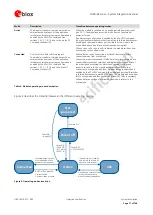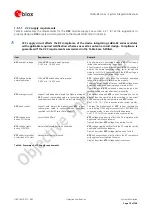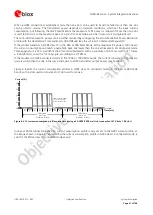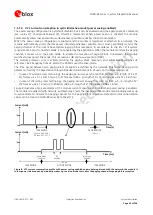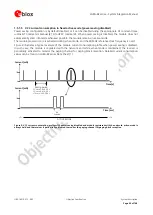
LARA-R2 series - System Integration Manual
UBX-16010573 - R02
Objective Specification
System description
Page 16 of 148
1.4
Operating modes
LARA-R2 series modules have several operating modes. The operating modes defined in Table 4 and described in
detail in Table 5 provide general guidelines for operation.
General Status
Operating Mode
Definition
Power-down
Not-Powered Mode
VCC
supply not present or below operating range: module is switched off.
Power-Off Mode
VCC
supply within operating range and module is switched off.
Normal operation
Idle-Mode
Module processor core runs with 32 kHz reference generated by the internal oscillator.
Active-Mode
Module processor core runs with 26 MHz reference generated by the internal oscillator.
Connected-Mode
RF Tx/Rx data connection enabled and processor core runs with 26 MHz reference.
Table 4: Module operating modes definition
Mode
Description
Transition between operating modes
Not-Powered
Module is switched off.
Application interfaces are not accessible.
When
VCC
supply is removed, the module enters not-powered mode.
When in not-powered mode, the modules cannot be switched on by
PWR_ON
,
RESET_N
or RTC alarm.
When in not-powered mode, the modules can be switched on applying
VCC
supply (see 2.3.1) so that the module switches from not-powered
to active-mode.
Power-Off
Module is switched off: normal shutdown by an
appropriate power-off event (see 1.6.2).
Application interfaces are not accessible.
When the module is switched off by an appropriate power-off event
(see 1.6.2), the module enters power-off mode from active-mode.
When in power-off mode, the modules can be switched on by
PWR_ON
,
RESET_N
or RTC alarm (see 2.3.1): the module switches
from power-off to active-mode.
When in power-off mode, the modules enter not-powered mode by
removing
VCC
supply.
Idle
Module is switched on with application
interfaces temporarily disabled or suspended:
the module is temporarily not ready to
communicate with an external device by means
of the application interfaces as configured to
reduce the current consumption.
The module enters the low power idle-mode
whenever possible if power saving is enabled by
AT+UPSV (see
u-blox AT Commands Manual
reducing power consumption (see 1.5.1.4).
The
CTS
output line indicates when the UART
interface is disabled/enabled due to the module
idle/active-mode according to power saving and
HW flow control settings (see 1.9.1.3, 1.9.1.4).
Power saving configuration is not enabled by
default: it can be enabled by AT+UPSV (see the
u-blox AT Commands Manual
The module automatically switches from active-mode to idle-mode
whenever possible if power saving is enabled (see sections 1.5.1.4,
1.9.1.4, 1.9.2.4 and to the
u-blox AT Commands Manual
[2], AT+UPSV
command).
The module wakes up from idle to active mode in the following events:
Automatic periodic monitoring of the paging channel for the
paging block reception according to network conditions (see
1.5.1.3, 1.9.1.4)
Automatic periodic enable of the UART interface to receive and
send data, if AT+UPSV=1 power saving is set (see 1.9.1.4)
Data received on UART interface, according to HW flow control
(AT&K) and power saving (AT+UPSV) settings (see 1.9.1.4)
RTS
input set ON by the host DTE, with HW flow control disabled
and AT+UPSV=2 (see 1.9.1.4)
DTR
input set ON by the host DTE, with AT+UPSV=3 (see 1.9.1.4)
USB detection, applying 5 V (typ.) to
VUSB_DET
input (see 1.9.2)
The connected USB host forces a remote wakeup of the module
as USB device (see 1.9.2.4)
The connected u-blox GNSS receiver forces a wakeup of the
cellular module using the GNSS Tx data ready function over the
GPIO3
pin (see 1.9.4)
The connected SDIO device forces a wakeup of the module as
SDIO host (see 1.9.5)
RTC alarm occurs (see
u-blox AT Commands Manual
[2], +CALA)
















